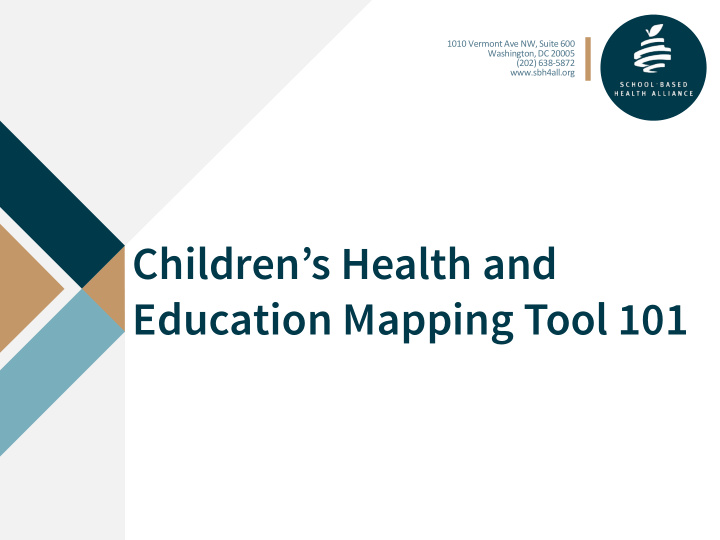



1010 Vermont Ave NW, Suite 600 Washington, DC 20005 (202) 638-5872 www.sbh4all.org Children’s Health and Education Mapping Tool 101
Help Us Count! Are you joining as a group? If you are viewing as a group, go to the “Chat” icon and type in the name of the person registered and the total number of additional people in the room. e.g., Tammy Jones +3
We Believe… In the transformational power of the health and education intersection
REMINDERS All attendees are in listen-only mode. We want to hear your questions! To ask a question during the session, use the “Chat” icon that appears on the bottom your Zoom control panel. Please complete evaluation poll questions at the end of the presentation.
WEBINAR ARCHIVE • Youth-Led 2-Part Webinar Series • The State of the Science: Teen Brain Development and the Impact of Marijuana • Quality Counts: How to Download and Use Your 2016-17 NQI Reports and • Hallways to Health 4-Part Webinar Series Prepare for 2017-18 Reporting http://www.sbh4all.org/webinars
TODAY’S PRESENTER Dr. Hayley Love Vice President, Research and Evaluation
CHILDREN’S HEALTH AND EDUCATION MAPPING TOOL Children’s Health and Education Mapping Tool
What is the Children’s Health and Education Mapping Tool? A GIS mapping tool designed to support diverse users to: 1) Identify geographic areas where disparities in child health, education, and socio-economic status exist, and 2) Develop school-based strategies to address these disparities.
What can you do with the mapping tool? • Data that are traditionally reported in separate silos can be searched, mapped, downloaded, and compared to national averages. • Users can view the locations of SBHCs, schools, and community partners, and strategically plan for future expansion of SBHCs.
What are the data sources for the tool? • US Census Bureau’s American Community Survey • National Center for Education Statistics Natality Files • Centers for Disease Control’s (CDC) Diabetes Interactive Atlas • CDC Atlas • US Department of Agriculture (UDSA) Food Atlas • Comprehensive Housing Affordability Strategy data • FBI Uniform Crime Reporting • 2016-17 National School-Based Health Care Census
What indicators are included in the tool? • Health Insurance and Coverage Indicators • Health Indicators • Education Indicators • Demographic and Socioeconomic Status Indicators
What are the limitations of the data? • County-level is the smallest geographic denomination with good data, but the indicators may vary within a county, such as at the neighborhood level • Data may be from different years, outdated, or missing • The tool cannot explain causation of indicator values • Testing for statistically significant differences is not available in the tool
www.sbh4all.org/mappingtool
Three Use Cases 1. Expanding SBHCs in high need areas in North Carolina 2. Integrating SBHCs into a strategy to reduce unintended teen pregnancy in Arkansas 3. Identifying SBHCs in a congressional district in California who are using telehealth
BECOME A MEMBER! BECOME A MEMBER!
THANK YOU! Additional Questions? Contact Dr. Hayley Love at hlove@sbh4all.org
Recommend
More recommend